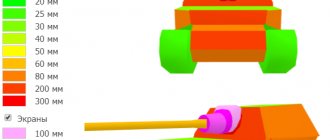Historical reference
TNH T Vz. 51 is a continuation of the development of the TVP project (which was closed due to the adoption of the T-34-85) with wider use of Soviet and Czechoslovak developments. In particular, it was planned to use developments on the TVP T 51, which was already proposed. This affected the shape of the hull and turret, as well as the design of the chassis. Work on the project was curtailed due to the unification of the weapons of the Warsaw Pact member countries. Already in 1958, Czechoslovakia launched the production of licensed T-54s.
Digital TV receiver World Vision T37
Budget model with DVB-T2 support “The highest skill is to know the true price of everything” François de La Rochefoucauld
The spread of digital terrestrial broadcasting of the DVB-T2 standard on the territory of the Russian Federation has led to the explosive growth of the market for stand-alone TV tuners (in the future we will use the established term “receivers”), connected to televisions, as a rule, via HDMI or a composite interface (some models implement SCART and/or component YPbPr outputs). The reasons are simple. Firstly, there is an impressive fleet of televisions either without support for digital terrestrial broadcasting, or with support for the first version of DVB-T, while many models simply have not become obsolete in terms of diagonals and resolutions. Secondly, receivers can record video from the air, including according to a schedule, and then play back television programs.
We have previously reviewed some models, in particular BBK SMP137HDT2, Kaskad VA2206HD, Openbox T2-02HD mini and Openbox T2-02M HD, but this is the first time that World Vision products have entered our laboratory.
The receiver, under the laconic name World Vision T37, is a budget model. Let's try to figure out how this positioning affected functionality.
Contents of delivery
World Vision T37 comes in a compact blue and white box with a picture of the receiver, a fully localized description of the device's capabilities and a reminder of the company's two-year warranty.
In addition to the receiver itself, the kit includes:
- remote control;
- 3 RCA - 3 RCA composite cable for analog video and audio connections;
- user guide;
- warranty card.
Design and specifications
The manufacturer claims the following features of the World Vision T37:
- DVB-T/DVB-T2 support;
- support of standards: Single PLP, Multi PLP;
- Demodulator modes: QPSK,16QAM,64QAM;
- frequency range - 174-230 MHz (VHF), 470-862 MHz (UHF);
- estimated consumption - 8 W, maximum up to 10 W;
- standby consumption - up to 1 W;
- input signal level - from −75 to +20 dBm W;
- video decoder - MPEG-1, MPEG-2, MPEG-4 HD, H.264, DivX (free version);
- audio decoder - MPEG-1, MPEG-2 (Layer I/II), MP3, AC-3, AAC-LC, HE-AAC;
- maximum bitrate of the input stream - up to 45.5 Mbit/s;
- image format - 4:3/16:9;
- audio formats - MPEG Layer I&II, 32/44.1/48 kHz;
- electronic schedule of EPG channels;
- delayed viewing mode TimeShift;
- video recording function (PVR);
- JPEG and BMP support;
- USB 2.0 port for connecting external USB-compatible devices with FAT16, FAT32 and NTFS file systems;
- support for MKV (Matroska) and TS containers.
The World Vision T37 body is visually divided into two parts, the left one is made of matte plastic with the manufacturer’s name and the DVB-T2 logo on the front panel and the right one is glossy with an IR sensor and an LED indicator there.
The rear panel contains an IEC antenna connector, an HDMI connector, and three RCA connectors for composite video and stereo audio.
The receiver has a built-in power supply; the cable cannot be disconnected.
On the bottom you can see ventilation holes and 4 legs, 2 plastic and 2 rubber.
The retail origin of the test copy did not allow us to photograph the printed circuit board, so we will limit ourselves to listing the chips used.
The World Vision T37 is based on a single-chip system (system-on-a-chip, SoC) ALi M3821 manufactured by ALi Corporation, introduced in the summer of 2014. According to the manufacturer, the combination of the M3821 with MaxLinear RF units (the device uses the MxL608, which is a cheaper modification of the MxL603) provides a high level of protection against interference caused by 4G/LTE, Wi-Fi and FM signals. This combination is complemented by a DDR3-800 memory module with a capacity of 64 MB.
The receiver was tested with a Samsung LE40B530P7W TV; an AVerMedia Live Gamer HD card and the composite input of the AVerTV Express 009 (M798B) TV tuner were used for capture.
Remote control
World Vision T37 comes with a 35-button remote control.
The remote control lies quite comfortably in the hand, the size of the buttons does not cause discomfort, pressing is informative, the angles of operation with the remote control exceed the 30 degrees from the perpendicular stated in the specifications.
List of broadcast channels during testing
Digital broadcasting in Samara is carried out at frequencies of 522 MHz (first multiplex) and 762 MHz (second multiplex) with MPLP (Multiple Physical Layer Pipes) technology, allowing different modulation schemes and different levels of error tolerance for different streams in the multiplexed DVB-T2 signal.
Connection
Connecting devices of this class is extremely simple; in addition to the antenna, in the case of a TV with an HDMI input, an appropriate cable is sufficient, however, due to the absence of one in the package, it is better for the potential user to look for a cable in advance.
Composite video output and analog audio outputs work simultaneously with HDMI, video modes with 24, 25 and 50 frames per second in the settings correspond to the PAL standard, with 30 and 60 frames per second - to the NTSC standard.
Settings
When you first start, you are asked to select the region, language, resolution and aspect ratio, for some reason translated as “TV Standard”
after which an automatic channel search starts.
Despite the hardware being similar to the BBK SMP137HDT2, the interface of the World Vision T37 is noticeably different, apparently due to the absence of significant deviations from the reference design. All operations are carried out within one window, which often contains only one line, which reduces usability.
In addition to automatic search on the OIRT frequency grid (178-226 MHz, channels 6-12, and 470-860 MHz, channels 21-69), channel search with range selection and frequency search with manual input and bandwidth selection are available (6, 7 and 8 MHz). You can also enable/disable logical channel numbering here.
Signal level and quality percentage values are displayed immediately after entering the frequency.
Sorting by uniquely assigned numbers (LCN) and by Service ID in the order they are transmitted in the stream is not implemented in the device.
The Channel Manager section provides access to editing and deleting.
Contextual operations are carried out using colored buttons on the remote control, alphabetical sorting by name in forward and reverse order, display of open/encrypted, blocking,
renaming (performed using the numeric buttons on the remote control, the on-screen keyboard is not supported)
and moving in the list.
The channel list is called up by the OK button on the remote control.
The information panel displayed by pressing the INFO button does not clearly display the time elapsed since the start of transmission.
Pressing the button again brings up more information about the channel, including level (translated as "Strength" and signal quality).
Teletext is processed correctly.
It would be nice to make the system settings scroll line more visible; the likelihood of missing the bottom two items is quite high.
The “Menu Language” subsection of the system settings section contains not only the setting of the same name, but also the teletext setting and the choice of priorities when there are several audio tracks in the stream.
In addition, the Audio button on the remote control allows you to switch between stereo, mono, left and right channel modes, respectively.
The “TV System” section contains resolution and frequency settings (1080i_25, 1080i_30, 1080p_50, 1080p_60, 1080p_25, 1080p_30, 1080p_24, By Source, By Native TV, 480i, 480p, 576i, 576p, 720p_50, 72 0p_60). The image format is also selected here (Auto, 4:3PS, 4:3LB, 16:9).
Automatic format adjustment, like the BBK SMP137HDT2, is not correct on all channels, but there is no confusion between 4:3 Letterbox and 16:9 in the World Vision T37.
In the “Video” section you can adjust brightness, contrast, saturation, hue and clarity; these settings are typical for ALi Corporation chipsets; competing solutions from Novatek Microelectronics and MStar Semiconductor do not have them.
World Vision T37 does not have an external display to display the time, but correct installation may be necessary to use the scheduler. The DVB-T2 standard supports time transmission, however, the user can select a region, time zone or manually configure it.
The 8-position timer, which can be configured from the EPG window, supports both recording (one-time and daily) and viewing; during testing, the device was brought out of standby mode and went into standby mode upon completion of the active task without any complaints.
Parental controls are supported (default password is 0000), the minimum age can be set to 10, 12, 14, 16 and 18 years old and the menu can be locked.
The menu settings set the display time (from 1 to 10 seconds at 1 second intervals) and transparency (off, 10%, 20%, 30%, 40%).
The “Media Information” section allows you not only to specify the capacity, but also to select the recording type (recording and Timeshift delayed viewing mode, recording only, Timeshift only).
In the “PVR settings” section you can activate the Timeshift mode, set the time transition (30 seconds, 1 minute, 5 minutes, 10 minutes, 30 minutes) and the option to save the corresponding file.
Enabling additional antenna power is in the “Advanced” section, along with filtering encrypted channels and setting automatic shutdown, which is not particularly useful in the conditions of open domestic broadcasting.
The "Tools" section contains information about the firmware, returning to factory settings, launching two games (Othello and Sudoku), updating the firmware via broadcast stream (not supported) or via USB, and safely removing the connected drive.
Information about the firmware of the test unit is presented below; at the time of testing there were no updates on the manufacturer’s website.
To record programs and use the Timeshift delayed viewing mode, you need a USB drive connected to the USB port. With available drives of various sizes formatted in NTFS, including the Seagate Expansion Portable STBX2000401 2 TB hard drive, which caused difficulties for the Kaskad VA2206HD, the World Vision T37 worked correctly during testing.
The ALIDVRS2 folder is created on the connected drive, for each recorded fragment its own folder is created with the date in the name, recording is carried out in TS format, and two service files with *.dvr extensions are created.
In standby mode, no power is supplied to the connected storage device.
During direct recording (the “Record” button on the remote control), pressing the button again allows you to set the recording time. Ending recording with the stop button requires confirmation, which eliminates accidental interruption; when the deferred viewing mode is active, recording is performed from the moment recording begins.
The built-in media player is capable of displaying recorded files, video files, audio files and image files.
In the “PVR” section you can rename, lock with a password and delete recorded fragments.
World Vision T37 does not support Dolby Digital decoding, the built-in player does not work with subtitles and does not remember where you stopped after exiting.
Devices of this class do not have absolutely correct support for playing 24p video materials (23,976 and 24 frames/s), however, the negative effect can be minimized to a comfortable level by selecting the video mode.
Quality
The image quality when working with DVB-T and DVB-T2 is determined by the operator in the range from low resolutions with low bitrates to HDTV. DVB-T2 channels are currently only available in standard definition.
HDMI
Composite output
Recorded fragments can be downloaded from the following links: fragment 1, fragment 2.
The time from turning on the device until the image appears is about 17 seconds.
Despite the budget receiver and the general positioning of the device, World Vision T37 provides good quality of reception of digital channels; within one PLP, switching between channels takes about 2 seconds, between channels in different PLPs - up to 3 seconds.
The heating of the device during operation can be described as moderate, but it would not hurt to take care of air circulation in the lower part of the device, where the ventilation holes are located.
conclusions
pros
- correct work with MPLP;
- good reception quality;
- compactness;
- TimeShift delayed viewing mode (if there is a connected drive);
- support for power-saving mode for scheduled tasks.
Minuses
- on time;
- lack of display;
- lack of possibility of end-to-end antenna connection;
- lack of support for Dolby Digital decoding;
- mediocre implementation of the built-in player.
World Vision T37 clearly demonstrates the difference between receivers on similar chipsets from different manufacturers: BBK's approach to the interface provides greater ease of use. Despite the budget version of the HF unit, the device copes with the reception of digital channels and is suitable for recording broadcast programs, however, for use as a player, it makes sense to pay attention to other models.
| Average price according to price.ru |
| N/A(0) |
| Average price according to Yandex.Market |
| T-12391933 |
| Offers based on Yandex.Market data |
| L-12391933-10 |
Video reviews
I was stunned when I realized that this was a cool video! ☀ REVIEW: TNH T Vz. 51
TNH T VZ. 51 — GORGEOUS TRAFFIC LVL IX ● How to play Vz 51 ● Best For You
TNH T Vz. 51 "Rags to Riches"









